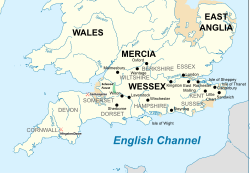
Back Уессекс Abkhazian Westseaxena Rīce ANG مملكة وسكس Arabic ويسيكس ARZ Reinu de Wessex AST وسکس کراللیغی AZB Уэсекс Byelorussian Ўэсэкс BE-X-OLD Уесекс Bulgarian ওয়েসেক্স Bengali/Bangla
Kingdom of the West Saxons | |||||||||||
|---|---|---|---|---|---|---|---|---|---|---|---|
| c. 519–886 | |||||||||||
 Southern Britain in the ninth century | |||||||||||
| Status | Independent kingdom (c. 519 – c. 645; 648–886) Client state of Mercia (645–648) | ||||||||||
| Official languages | West Saxon Old English | ||||||||||
| Religion | Paganism (before 7th century) Christianity (after 7th century) | ||||||||||
| Government | Monarchy | ||||||||||
| King (List) | |||||||||||
• c. 519 – c. 534 | Cerdic (first) | ||||||||||
• 688–726 | Ine | ||||||||||
• 802–839 | Ecgberht | ||||||||||
• 871–886 | Alfred the Great (last) | ||||||||||
| History | |||||||||||
• Established | c. 519 | ||||||||||
• Alfred the Great declares himself as King of the Anglo-Saxons[1] | 886 | ||||||||||
| Currency | Penny | ||||||||||
| |||||||||||
| Today part of | |||||||||||
The Kingdom of the West Saxons, also known as the Kingdom of Wessex, was an Anglo-Saxon kingdom in the south of Great Britain, from around 519 until Alfred the Great declared himself as King of the Anglo-Saxons in 886.[2]
The Anglo-Saxons believed that Wessex was founded by Cerdic and Cynric of the Gewisse, though this is considered by some to be a legend. The two main sources for the history of Wessex are the West Saxon Genealogical Regnal List and the Anglo-Saxon Chronicle (the latter of which drew on and adapted an early version of the List), which sometimes conflict.[3] Wessex became a Christian kingdom after Cenwalh (r. 642–645, 648–672) was baptised and was expanded under his rule. Cædwalla later conquered Sussex, Kent and the Isle of Wight. His successor, Ine (r. 689–726), issued one of the oldest surviving English law codes and established a second West Saxon bishopric. The throne subsequently passed to a series of kings with unknown genealogies.
During the 8th century, as the hegemony of Mercia grew, Wessex largely retained its independence. It was during this period that the system of shires was established. Under Egbert, Surrey, Sussex, Kent, Essex, and Mercia, along with parts of Dumnonia, were conquered. He also obtained the overlordship of the Northumbrian king. However, Mercian independence was restored in 830. During the reign of his successor, Æthelwulf, a Danish army arrived in the Thames estuary, but was decisively defeated. When Æthelwulf's son, Æthelbald, usurped the throne, the kingdom was divided to avoid war. Æthelwulf was succeeded in turn by his four sons, the youngest being Alfred the Great.
Wessex was invaded by the Danes in 871, and Alfred was compelled to pay them to leave. They returned in 876, but were forced to withdraw. In 878 they forced Alfred to flee to the Somerset Levels, but were eventually defeated at the Battle of Edington. During his reign Alfred issued a new law code, gathered scholars to his court and was able to devote funds to building ships, organising an army and establishing a system of burhs. Alfred's son, Edward, captured the eastern Midlands and East Anglia from the Danes and became ruler of Mercia in 918 upon the death of his sister, Æthelflæd. Edward's son, Æthelstan, conquered Northumbria in 927, and England became a unified kingdom for the first time. Cnut the Great, who conquered England in 1016, created the wealthy and powerful earldom of Wessex, but in 1066 Harold Godwinson reunited the earldom with the crown and Wessex ceased to exist.
- ^ Keynes 1998, p. 26.
- ^ Keynes 1998, p. 23-24.
- ^ David N. Dumville, 'The West Saxon Genealogical Regnal List and the Chronology of Early Wessex', Peritia, 4 (1985), 21–66.